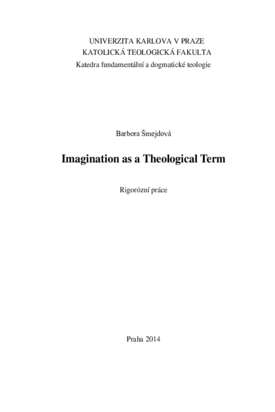Imagination as a Theological Term
Imagination as a Theological Term
rigorous thesis (DEFENDED)

View/
Permanent link
http://hdl.handle.net/20.500.11956/66439Identifiers
Study Information System: 153674
CU Caralogue: 990019944130106986
Collections
- Kvalifikační práce [2276]
Author
Referee
Ryšková, Mireia
Faculty / Institute
Catholic Theological Faculty
Discipline
Catholic Theology
Department
Department of systematic Theology and Philosophy
Date of defense
9. 9. 2014
Publisher
Univerzita Karlova, Katolická teologická fakultaLanguage
Czech
Grade
Pass
Cílem rigorózní práce Představivost jako teologický pojem je uchopit téma představivosti na poli teologie jak v teoretické tak i v praktické rovině. Práce vychází z teorie představivosti Paula Ricoeura, který pojímá téma z lingvistického hlediska. První kapitola, která je věnována právě Ricoeurově teorii, představuje téma z hlediska teorie vyprávění, metafory a symbolu. Druhá kapitola se věnuje teologické reflexi představivosti z perspektivy tří autorů: J. H. Newmana, K. Rahnera a H. U. von Balthasara. Newman popisuje představivost na základě svého rozlišení mezi reálnou a pojmovou shodou. Rahner se věnuje představivosti z hlediska různých druhů umění a von Balthasar přichází s celým propracovaným konceptem teologické estetiky. Tyto různé pohledy nám nabízejí otevření několika klíčových témat. Kapitola se proto dotýká problematiky jazyka teologie, který nemá pouze působit na rozum posluchačů ale i na jejich srdce. Dále ukazuje, jakým způsobem k nám mluví jednotlivá umění a za jakých podmínek se umění stává teologickým výrazem. V neposlední řadě představuje samotné pojetí člověka jako imaginativní bytosti a objasňuje, že jazyk představivosti je také způsob jakým mluví Bůh k člověku skrze své stvoření, Písmo a nakonec skrze svého Syna. Celá práce je uzavřena třetí kapitolou, která se věnuje přínosu...
The aim of the rigorous work called Imagination as a Theological Term is to grasp the theme of imagination in the field of theology both in theory and practice. The work is grounded on the theory of imagination of Paul Ricoeur, who approaches the theme from a linguistic perspective. The first chapter, which is devoted to Ricoeur's theory, introduces his concept of narrative, metaphor and symbol. The second chapter deals with the theological reflexion of imagination from the point of view of three authors: J. H. Newman, K. Rahner and H. U. von Balthasar. Newman describes imagination by his distinction of real and notional assent. Rahner introduces the theme from the perspective of various kinds of arts, and von Balthasar comes with a concise project of theological aesthetics. These various points of view enable us to open several important questions. The chapter thus touches the theme of theological language which should appeal not only to the reason of the listeners but also to their heart. After that it shows how various kinds of art speak to us and on which condition they can serve as a theological expression. Finally, it introduces the theme of man as an imaginative being and shows that the language of imagination is also the language of God, who reveals himself to man by his creation, Holy...
